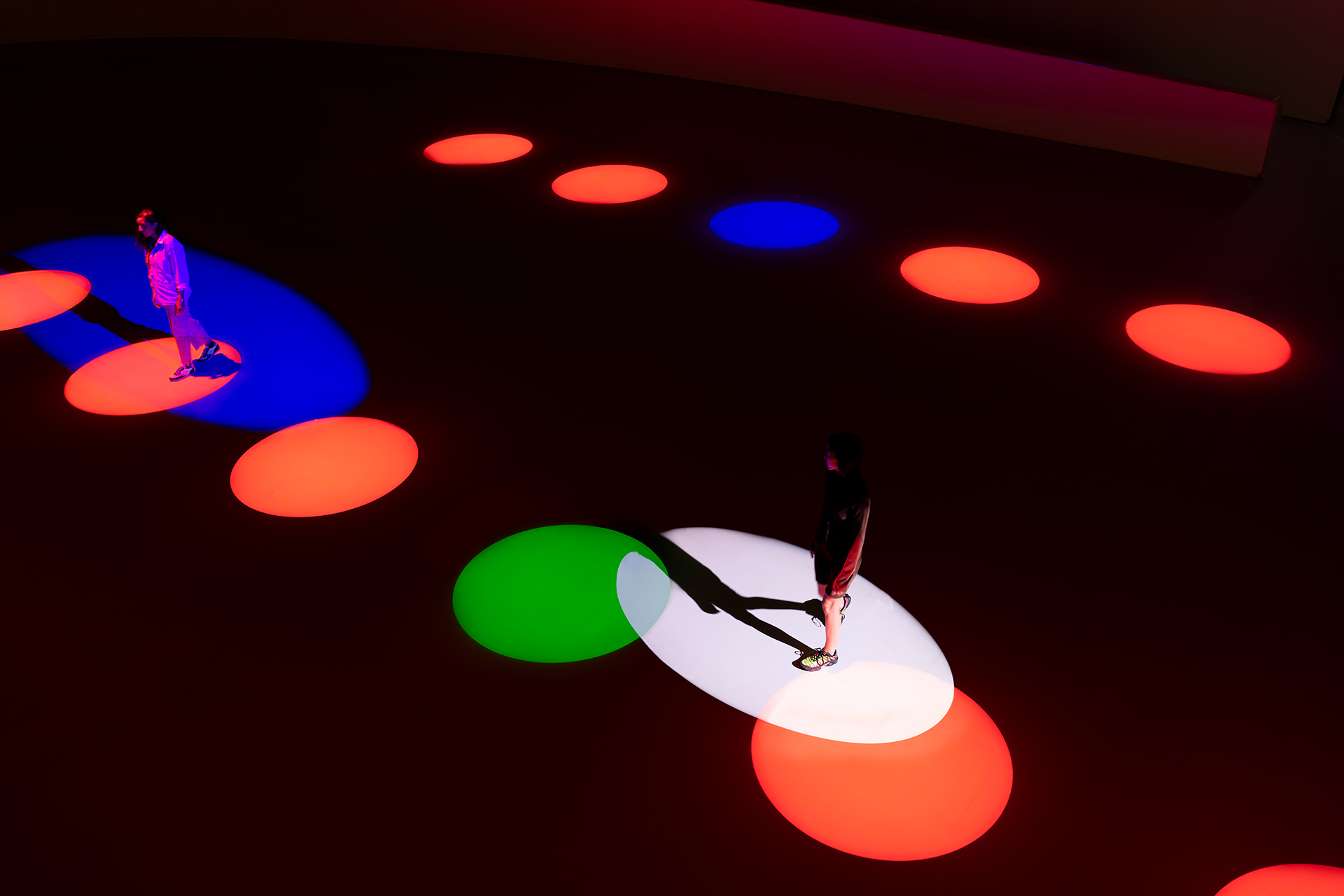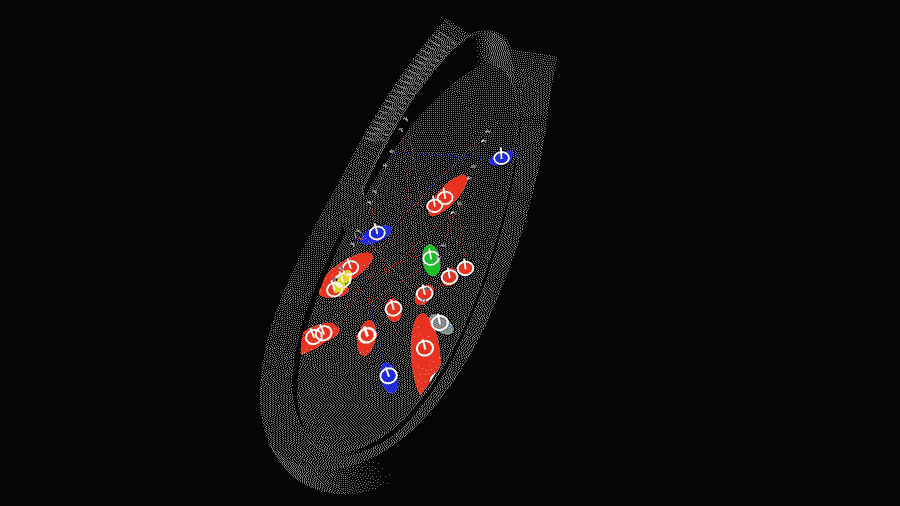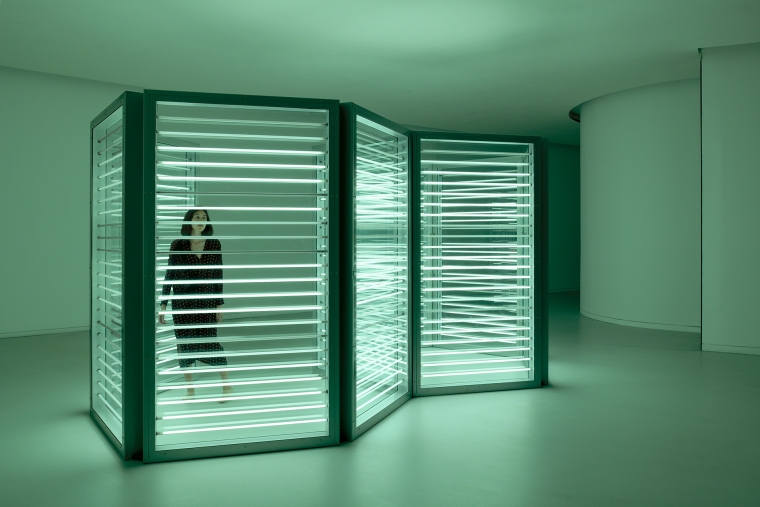
Lisbon Dots
Carsten Höller
Lisbon Dots is a new work by Carsten Höller that is being presented at maat for the very first time (until 28 February 2022), in the context of his exhibition DAY.
Installed in the large oval room in the centre of the museum, Lisbon Dots consists of 20 spotlights in four colours which follow people’s movements and allow them to play a “reward and punishment” game with each other. Initially, there are 14 red, 3 blue and 2 green dots and a single white one. People with a red dot can “upgrade” to a blue dot by overlapping theirs with a blue one for a certain amount of time. The amount of overlap also plays a role. From blue, players can “upgrade” to green and then to white, with the respective blue, green and white dots losing their “status” and being “downgraded” by one colour step. However, if all the red dots are united by forming an uninterrupted chain or cluster, all 20 dots turn white. This situation lasts until 7 or more white dots no longer overlap with the other white dots. At this point, the game is over, and the colour dots revert to the initial constellation.
According to Vincent de Belleval, who assisted Carsten Höller in the making of this work, “Lisbon Dots relies on using the visitors' positions in the whole oval gallery which is acquired through a network of sensors which creates a map of the space and extracts the position of people in real time. This positional information is then sent to our game engine which assigns people spotlights if they either step on a dot or step through a specific region of the gallery. Once a spotlight is controlled by a person it is part of the game and can progress through the colour series: red, green, blue and finally white. On a technical level, the main challenge in the oval room is the complex geometry of the space as it makes calibration and alignment very difficult. We had to develop a method to get the exact position of each spotlight in the ceiling based on reference points on the floor. Using the same points, we can also align all the sensors so that all our virtual worlds and the real world align as well as possible.”
|
After earning a PhD in phytopathology with a specialisation in chemical ecology at Kiel University in Germany, Carsten Höller has devoted himself exclusively to art since 1993. Höller applies his training as a scientist to his work as an artist, focusing particularly on the nature of human reasoning and interrelations. Notable installations include “Soma” (2010), a three-dimensional tableau vivant at Hamburger Bahnhof, in Berlin, featuring reindeer fed with fly agaric mushrooms; “Test Site” (2006), a series of giant slides installed in Tate Modern’s Turbine Hall; and “Upside-Down Goggles” (2009–11), an ongoing participatory experiment using vision distorting goggles. For Höller, the museum can be seen as a space for experimentation and for testing ideas and concepts that can eventually be enacted on a larger scale. “Synchro System”, referring to the synchronisation between viewer and artwork, between human beings and “machine effects”, was conceived by Höller for Fondazione Prada, Milan (2000) and consisted in the realisation of a “village of possibility” composed of psychophysical stimuli and interactive tools. Other major solo exhibitions by Höller include “7,8 Hz” at Le Consortium in Dijon (2004); “Carrousel” at Kunsthaus Bregenz in Austria (2008); “Experience” at New Museum in New York (2011); “Doubt” at Pirelli HangarBicocca in Milan (2016); and “Sunday” at Museo Tamayo in Mexico City (2019).
|
DAY (maat, 05/10/2021 – 28/02/2022) is a monographic exhibition by Carsten Höller curated by Vicente Todolí which brings together a vast array of works producing light and darkness, ranging from sculptures with lamps to projections and architecture dating from 1987, when Höller was working as a scientist, until today.
|

|
Above: “Lisbon Dots”, 2021, by Carsten Höller installed at maat (exhibition “DAY”, 05/10/2021–28/02/2022). Photos: Attilio Maranzano. Courtesy of the artist and EDP Foundation / maat. |
Below: Production layouts for “Lisbon Dots”, 2021, by Carsten Höller. Courtesy of the artist and Vincent de Belleval. |







